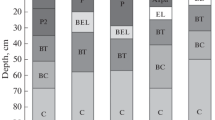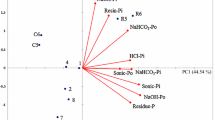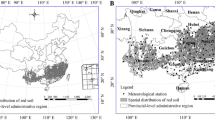Abstract
The hydrological balances for the agroforestry systems of Theobroma cacao with Cordia alliodora or Erythrina poeppigiana were calculated using measurements taken over four years (1983–1987) of the following parameters: climatic (precipitation, evaporation); edaphological (texture, soil moisture tension, hydraulic conductivity, variations in soil moisture content). Water fluxes (interception, simulation of transpiration and percolation) were estimated from one year of measurements (1986–1987).
Weekly samples of percolated water were taken from March 1986 – March 1987 using lysimetric capsules at 100 cm soil depth. N, P, K, Ca and Mg concentrations were determined to calculate the annual leaching losses. Nutrient concentration values were extrapolated for the whole 4 years observation period, in order to calculate leaching losses for the whole study period. Precipitation samples were also taken to determine the corresponding annual nutrient inputs.
Similar content being viewed by others
References
Alpizar, L, Fassbender, HW, Heuveldop, J, Fölster, H and Enriquez, G (1986) Modelling agroforestry systems of cacao (Theobroma cacao) with (Theobroma cacao) with laurel (Codia alliodora) and poro (Erythrina poeppigiana) in Costa Rica. I. Inventory of organic matter and nutrients.Agroforestry Systems 4: 175–189.
Barradas, VL and Fanjul, L (1984) La importancia de la cobertura arbórea en la temperatura del agroecosistema cafetalero. Biotica 9 (4): 415–421.
Boyer, J (1973) Cycles de la matiére organique et des éléments minéraux dans une cacaoyére camerounaise. Café, Cacao, Thé 17: 3–24.
Chareau, C (1972) Problemes poses par l'utilisation agricole des sols tropicaux par des cultures annuelles. Agronomie Tropicale 27: 905–929.
Diaz, Romeu R and Hunter, A (1978) Metodologia de muestras de suelos, análisis quimico e investigación de invernadero. Turrialba/Costa Rica. CATIE. 62p.
Doorenbos, J and Pruitt, WO (1984) Guidelines for predicting crop water requirements. Ed. rev. Roma FAO 144p. (FAO Irrigation and Drainage Paper no 24).
Doorenbos, J and Pruitt, WO (1976):Las necesidades de agua de los cultivos. Roma. FAO. 194p. (Estudio FAO: Riego y drenaje no 24).
Fassbender, HW (1987) Modelos edafológicos de sistemas agroforestales. Turrialba/Costa Rica, CATIE. 475 p.
Fassbender, HW, Alpizar, L, Heuveldop, J, Fölster, H and Enriquez, G (1988) Modelling agroforestry systems of cacao (Theobroma cacao) with laurel (Cordia alliodora) and poró (Erythrina poeppigiana) in Costa Rica III. Cycles of organic matter and nutrients. Agroforestry Systems6: 49–62.
Forsythe, W (1975) Fisica de suelos. San José/Costa Rica, IICA. 211 p.
Frissel, MJ, ed, (1978) Cycling of mineral nutrients in agricultural ecosystems. Amsterdam, Elsevier. 356 p.
Gavande, S (1972) Fisica de suelos; principios y aplicaciones. México, Limusa. 351 p.
Grimm, U and Fassbender, HW (1981) Ciclos biogeoquimicos en un ecosistema forestal de los Andes Occidentales de Venezuela. III Ciclos hidrológicos y translocación de elementos quimicos con el agua. Turrialba 31: 89–99.
Harvey, WR (1987) Mixed model least-squares and maximum likelihood computer program. Columbus, Ohio, Ohio State University.
Heuveldop, J, Fassbender, HW, Alpizar, L, Enriquez, G and Fölster, H (1988) Modelling agroforestry systems of cacao Theobromma cacao with laurel Cordia alliodora and poró Erythrina poeppigiana in Costa Rica. II. Cacao and wood production, litter production and decomposition. Agroforestry Systems 6: 37–48.
Hillel, D (1980) Fundamentals of soil physics. New York, Academic Press. 413 p.
Imbach, AC (1987) Lixiviación de nutrimentos pricipales en cuatro sistemas agroforestales con cultivos perennes de Turrialba, Costa Rica. M. Sc. Thesis. Turrialba/Costa Rica, CATIE — UCR. 167 p.
Jimenez, Otarola F (1986) Balance hidrico con énfasis en percolación de dos sistemas agroforestales: café-poró y café-laurel, en Turrialba/Costa Rica. M. Sc. Thesis. Turrialba/Costa Rica, CATIE-UCR. 104p.
Jordan, CF (1985) Nutrient cycling in tropical ecosystems. New York, Wiley. 179 p.
Jordan, CF (1982) The nutrient balance of an Amazonian rain forest. Ecology 63 (3): 647–654.
Jordan, CF (1978) Stem flow and nutrient transfer in a tropical rain forest. Oikos 31: 257–263.
Knight, DH, Fahey, TJ and Running, SW (1985) Water and nutrient outflow from contrasting lodgepole pine forests in Wyoming. Ecol Mon 55 (1): 29–48.
Oliveira, Leite J (1984) Perdas de agua e nutrientes em uma plantacaô de cacau do sul da Bahia. Revista Brasileira de Ciencia do Solo 8(3): 337–345.
Russell, AE (1983) Nutrients leaching during large storms in tropical successional ecosystems. M. Sc. Thesis. Gainesville/Florida, University of Florida. 140 p.
Russell, CE (1983) Nutrient cycling and productivity in native and plantation forests in Jari Florestal, Para, Brazil. Athens/Georgia, University of Georgia.
Rutter, AJ, Morton, AJ and Robins, PC (1975) A predictive model of rainfall interception in forests. II. Generalization of the model and comparison with observations in some coniferous and hardwood stands. J Appl Ecol 12: 367–380.
Rutter, AJ and Morton, AJ (1977) A predictive model of rainfall interception in forests. III. Sensitivity of the model to stand parameters and meteorological variables. J Appl Ecol 14: 567–588.
Santana, MBM and Cabala-Rosand, P (1985) Reciclagem de nutrients em uma plantacâo de cacau sombreada com Eritrina. In: Proc IX Int Res Conf, Togo 1984, pp 205–210. Lagos/Nigeria. Cocoa Producers Alliance.
Shaffer, KA, Fritton, DD and Baker, DE (1979) Drainage water sampling in a wet, dual pore system. J Env Qual 8: 241–246.
Schroeder, R (1951) Resultados obtenidos de una investigación del micro-clima en un cafetal. Cenicafe 2 (18): 33–43.
Suarez de, Castro F and Rodriguez, Grandas A (1962) Investigaciones sobre la erosión y la conservación de los suelos en Colombia. Bogotá/Colombia, federación Nacional de Cafeteros de Colombia. 473 p.
Ulrich, B, Benecke, P, Harris, WS, Khanna, PH and Mayer, R (1981) Soil processes. In: Reichle, DE, ed, Dynamic properties of forest ecosystems. Cambridge/England, Cambridge University Press. pp 265–339.
Author information
Authors and Affiliations
Rights and permissions
About this article
Cite this article
Imbach, A.C., Fassbender, H.W., Borel, R. et al. Modelling agroforestry systems of cacao (Theobroma cacao) with laurel (Cordia alliodora) and cacao with poro (Erythrina poeppigiana) in Costa Rica. Agroforest Syst 8, 267–287 (1989). https://doi.org/10.1007/BF00129654
Issue Date:
DOI: https://doi.org/10.1007/BF00129654




